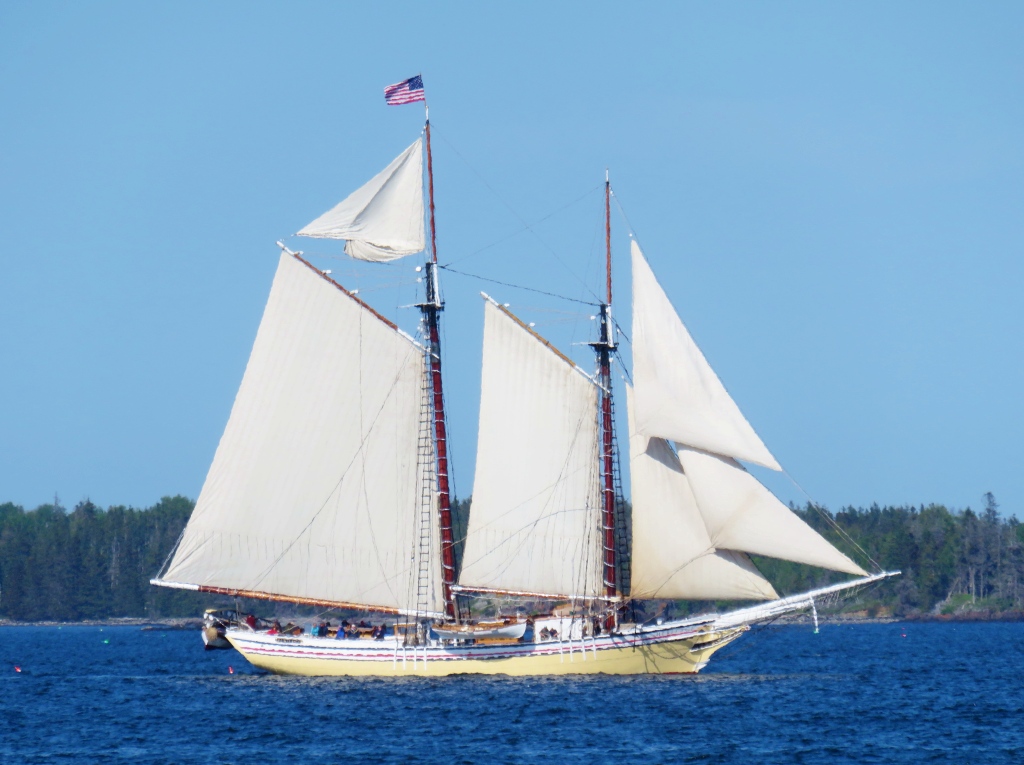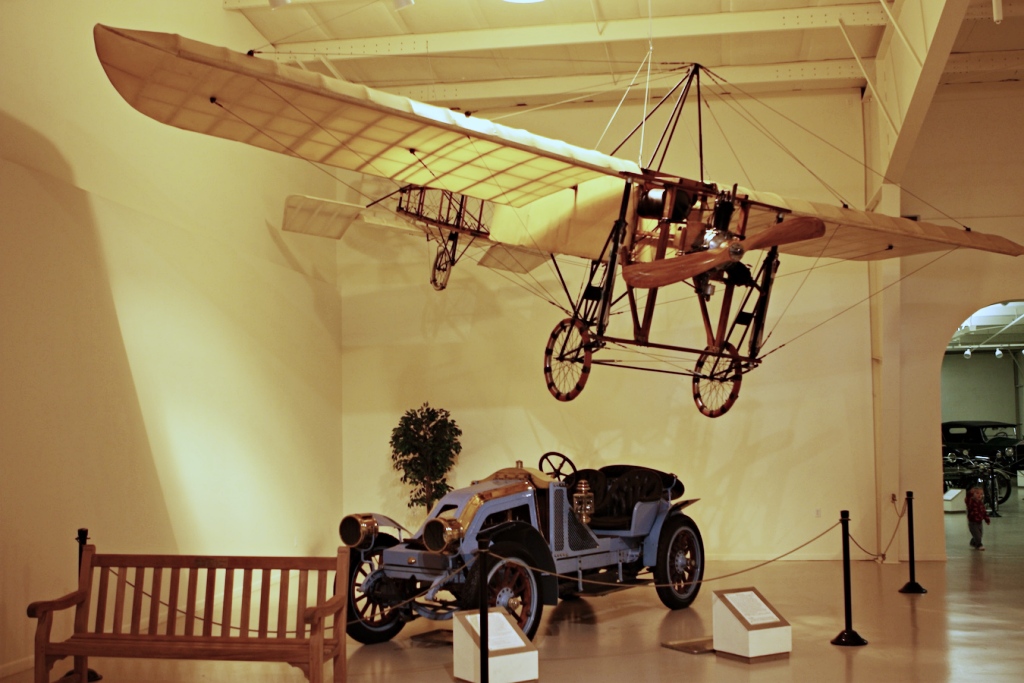Penobscot Bay Guide
Penobscot Bay has some of the loveliest towns in Maine, all of which share a rich maritime heritage: Rockland and Owl's Head, Camden, Castine, Blue Hill, Deer Isle and Stonington. Out to sea, there's Isle au Haut. If you're looking for a Maine Windjammer sailing adventure, you've come to the right place!
Transportation
Bus
Concord Coach Lines connects Rockland with Boston, Boston's Logan Airport, Portland ME, other coastal communities in the Penobscot region, and Bangor and Orono. Here's full information. The bus station in Rockland is in the Maine State Ferry Service Terminal, 517A Main Street (US Route 1), at Talbot Street (map).
Ferries to the Islands
The Maine State Ferry Service Terminal (tel 207-596-5400), 517A Main Street at Talbot Street (map), is where you catch ferries to the islands. of Vinalhaven, North Haven and Matinicus.

Make reservations in advance for vehicles! Vehicle tickets are date- and time-specific.
All passenger tickets are valid for any day, round-trip only, and non-refundable. Passengers can buy tickets in advance online, but as they are non-refundable, you may wish to wait and purchase tickets at the dock on the day of your voyage. Your ticket does not guarantee you a place on the ferry. Loading is first-come, first-served.
Vinalhaven
The car ferry takes 75 minutes for the 15-mile voyage.
North Haven
The car ferry takes 70 minutes for the 12.5-mile voyage.
Matinicus
The ferry takes 2-1/4 hours for the 23-mile voyage. Sailings depend on weather and tides, and the ferry departs the island within an hour of arrival, so you should probably plan to stay overnight.
Rockland Guide
Rockland, Maine, 78 miles (126 km) northeast of Portland (map), is a fine old Maine seaside town with an appealing, historic Main Street, a busy working harbor, lots of lobster boats, several significant art museums, excellent inns, good restaurants, two picturesque lighthouses, and numerous annual festivals and special activities that draw eager visitors.
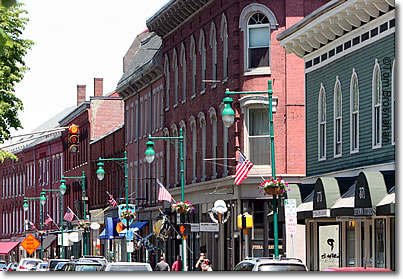
Main Street, Rockland, Maine
What to See & Do
Art Museums
Rockland's impressive list of art troves includes the renowned Farnsworth Art Museum and its adjunct, the Wyeth Center, with noted works by the Wyeth family of painters, as well as the Center for Maine Contemporary Art.
Farnsworth Art Museum
Farnsworth Art Museum
An excellent small museum specializing in artists who lived and/or worked in Maine: Winslow Homer, John Marin, Fitz Henry Lane, Louise Nevelson, and others. More...
Wyeth Center
An adjunct of the Farnsworth Art Museum, this fsmall ormer church holds many works by the Wyeth family of painters: Andrew Wyeth, Jamie Wyeth and N. C. Wyeth. More...
Center for Maine Contemporary Art
Founded in 1952 as a cooperative effort named Maine Coast Artists, the Center now boasts a Toshiko Mori-designed headquarters at 21 Winter Street in downtown Rockland. Over the years the center has shown and encouraged such artists as Alex Katz, Louise Nevelson, Fairfield Porter, Lois Dodd, Alan Magee, John Walker, Neil Welliver, Robert Indiana, and Jamie Wyeth. More...
Maine Lighthouse Museum
The rockbound coast of Maine is prime lighthouse territory, and the museum's exhibits tell you all about them. More...
Rockland Breakwater Lighthouse
The iconic lighthouse you see at the end of Rockland's mile-long breakwater jetty is accessible on foot, and in fine weather it's a wonderful walk.
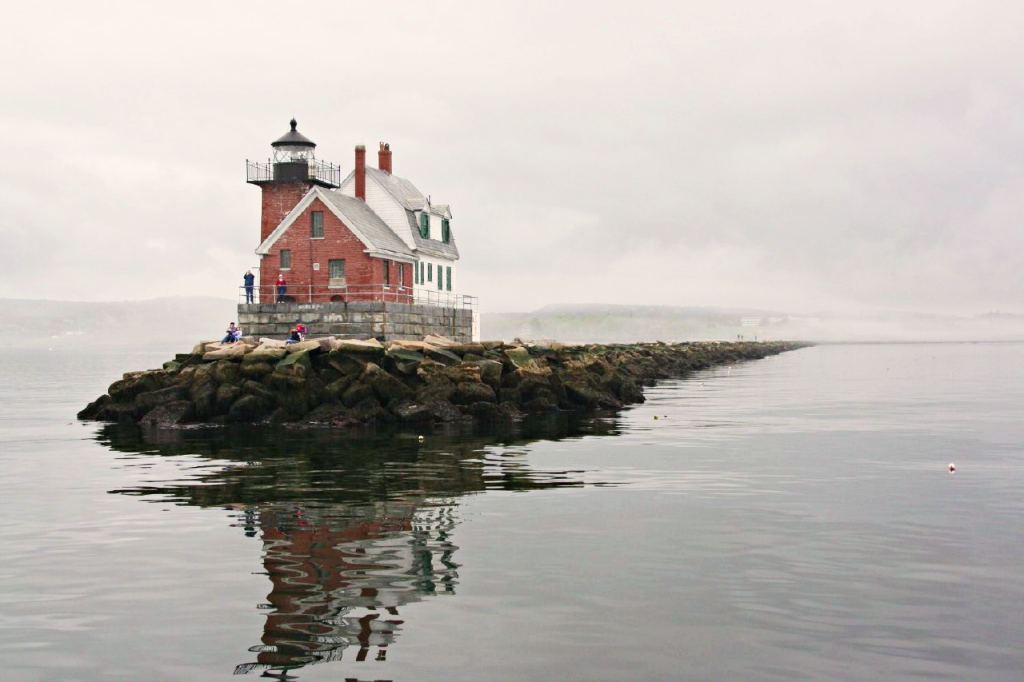
Rockland Light, at the end
of a mile-long jetty.
Puffin Project Visitor Center
Puffins, those lovable little birds that produce only one egg a year, were driven off many Maine islands by civilization, but the dedicated naturalists of the Audubon Seabird Institute, through the Puffin Project, have lured them and other disappeared birds back. An inspiring story! See it at the Visitor Center, 311 Main St. More...
Owl's Head Peninsula
If you're visiting Rockland, in need of an idyllic picnic spot or a swim in the brisk waters of the Atlantic, or just want to add another lighthouse to your life list, make the 5-mile (8-km) drive south and east to the Owl's Head peninsula (map).
If you're interested in the history of transportation, you have no choice: the Owl's Head Transportation Museum is a must-see!
Owls Head State Park
Owls Head Lighthouse, on a rocky promontory at the end of a peninsula overlooking Rockland harbor (map), is a familiar sight to all windjammers sailing along the coast.
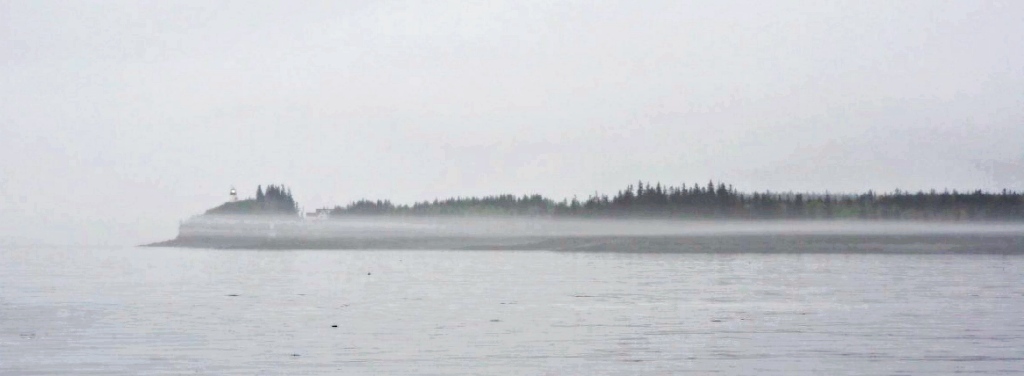
Owls Head Light at the left end of the peninsula
The lighthouse is in Owls Head State Park, which has picnic tables, pit toilets, and a small pebble-and-coarse-sand beach.
Admission to the park, lighthouse and beach are free.
As you drive into the park, you'll come to a parking area. Park here, as only authorized vehicles are allowed to go farther. Walk along the continuation of the road, bearing right for the lighthouse, left for the beach. The lighthouse is a five-minute walk, then up several dozen steps.
The view is spectacular!
On your way to Owls Head, note the quaint Owls Head Post Office and, next to it, the Owls Head General Store, which boasts that its hamburgers have been voted the best in Maine.
Farther along Lighthouse Road, the Owls Head Lobster Company on the right side of the road is a substantial operation.
Owl's Head Transportation Museum
Owl's Head Transportation Museum is among Maine's treasures, with its priceless stagecoaches, classic automobiles, aircraft, and an army of eager volunteers who restore, preserve, drive and fly them at any opportunity. Only 3.5 miles (5.6 km) south of the center of Rockland (map), it's wonderland for any technophile, with over 100 historic aircraft, automobiles, bicycles, motorcycles, carriages and engines in its permanent collection.
The museum's oldest aircraft dates from 1804, its oldest automobile from 1885.
My favorite flying machine—and there are dozens of planes here—is the 1900 Clark Ornithopter, a flying machine that flaps its wings like a bird. Difference:? Birds fly, Mr Clark's Ornithopter never did.
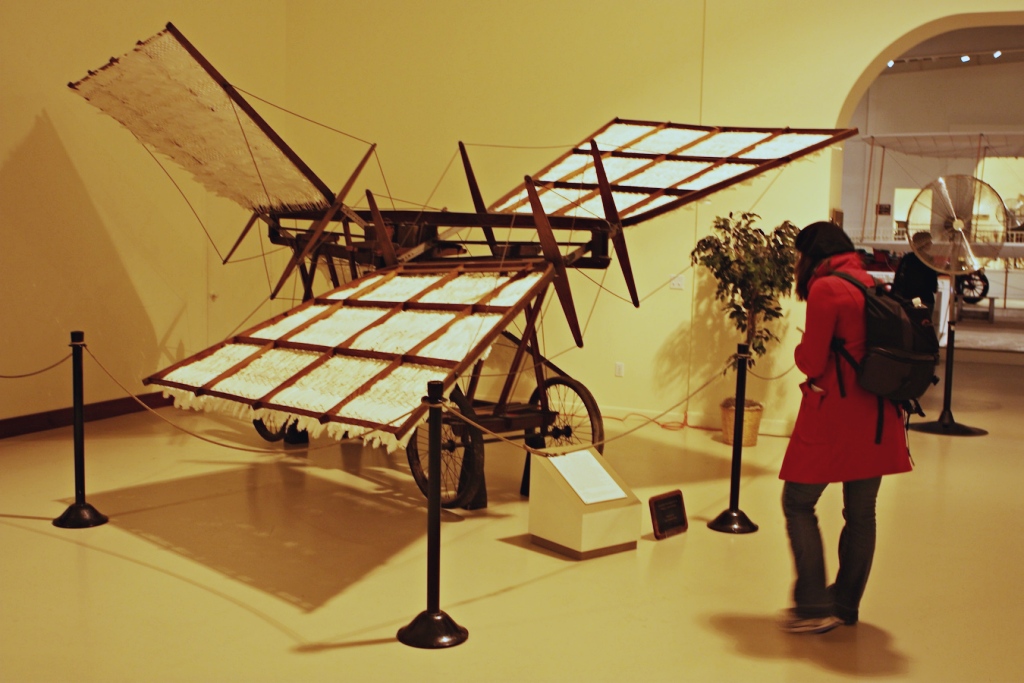
Clark Ornithopter at Owl's Head Transportation Museum.
Among the autos, the 1912 Woods Electric Brougham is from the time over a century ago when there were more electric cars than gasoline-powered cars on the road.
But my all-time favorite has to be the 1935 Stout Scarab, "the first minivan," with innovations such as aerodynamic design, unibody construction, rear-mounted V-8 engine, electric door locks, and a configurable interior that included a card table and movable seats.
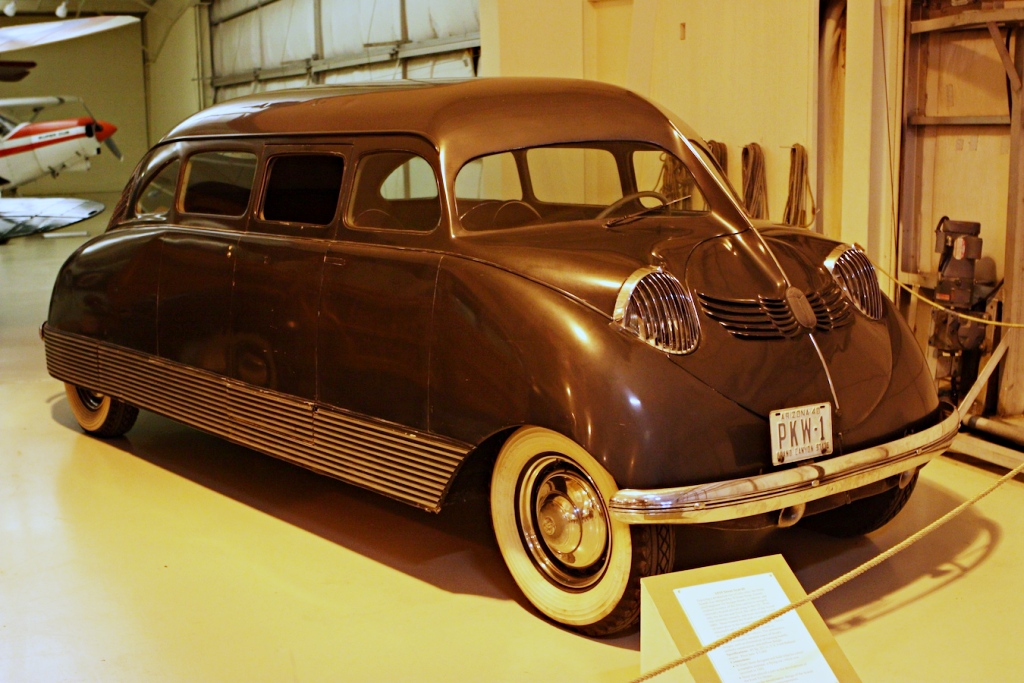
Stout Scarab (1935), the 'first minivan'.
The Owl's Head Transportation Museum is on Maine Route 73 3.5 miles (5.6 km) south of Rockland ME next to Knox County Regional Airport and near Owl's Head Lighthouse (map). It's open every day, all year, except for three major holidays.
Windjammers!
Rockland harbor, protected by a mile-long jetty, is the home port for many splendid Maine windjammers, tall sailing ships that will take you along the spectacular Maine coast on multi-day (and multi-night) nautical expeditions.
Take a cruise on a Maine windjammer...
Where to Stay
Rockland, Maine has fine old inns, and several comfortable hotels for travelers. Here's a Hotel Map with Prices:
Rockland Lobsters
Rockland likes to think of itself as the "Lobster Capital of the World," but however that may be, there are lots of Maine lobsters available in Rockland's surprisingly excellent restaurants.
In December, Rocklanders erect a lobster trap Christmas tree decorated with evergreens and colorful lobster-trap buoys.
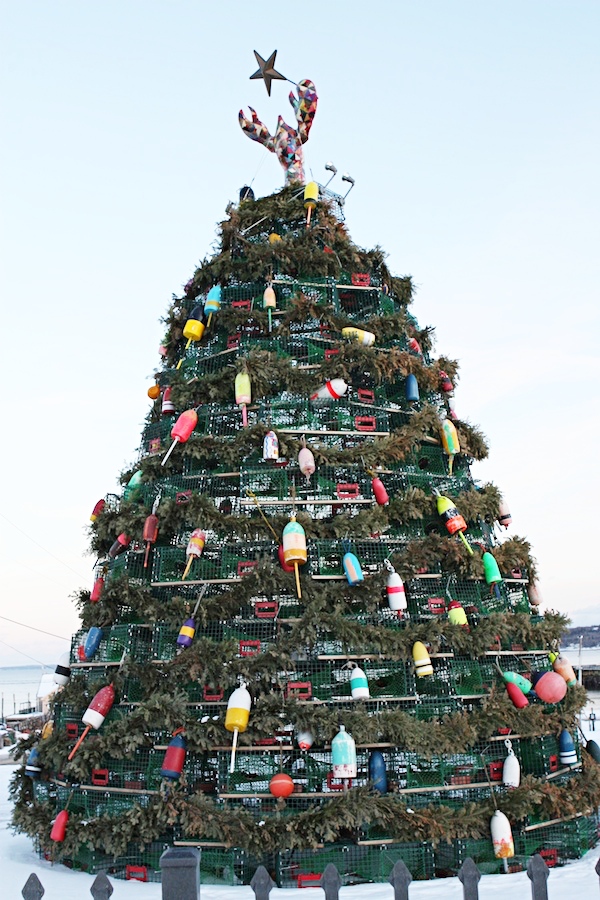
The Lobster Trap Christmas Tree.
That Big Factory
Rockland harbor has been the location of a huge carageenan-processing factory for nearly a century.
Carageenan, a long-chain polysaccharide with a backbone of the sugar galactose, is used as a thickener in puddings, toothpaste, and as a laboratory culture medium for bacteria. You see its name commonly on the ingredients labels of many processed foods.
Irish moss (Chondrus crispus), the sort of seaweed from which carageenan was first extracted, is plentiful in the sea near Rockland. In 1936, when the plant was established, most of the seaweed came from nearby. Now, farmed seaweed is shipped in from around the world.
Camden
A small, very pretty coastal town wedged between the salt waters of Penobscot Bay and a range of rocky hills, Camden is famous for poetry, parks and windjammers.
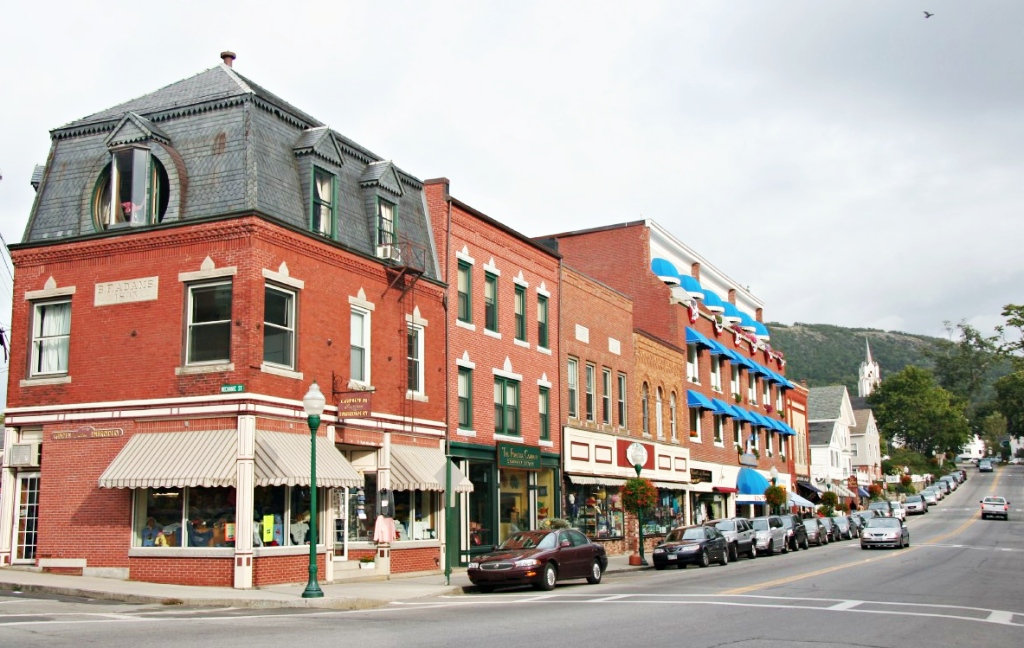
Main Street in Camden,
Maine.
Poet Edna St Vincent Millay (1892-1950) went to high school in Camden and began writing poetry here, later becoming the first woman to win the Pulitzer Prize for Poetry.
Today Camden's chief claim to fame is that it is the home port for several Maine windjammers that take eager landlubbers for cruises along the Maine coast.
What to See & Do
Enjoy the view from the summit of Mt Battie, explore the town where Edna St Vincent Millay grew up, and sail the Maine coast on a windjammer.
Mount Battie
The hills behind the town are included in the Camden Hills State Park, with campgrounds and picnic spots, and an auto road to the top of Mt Battie, the highest hill of the range.
If you have a car, drive north from town along US 1 and follow the signs to the entrance to Camden Hills State Park and the auto road to the top of Mt Battie (map). Besides the town itself, the drive up will afford you a view of the rocky hills, the countryside beyond, and of Penobscot Bay.
View of Camden from Mount Battie.
It was this view that poet Edna St Vincent Millay (1892-1950) described in her verse:
All I could see from where I stood
Was three long mountains and a wood;
I turned and looked another way,
And saw three islands in a bay.
Maine Windjammers
Camden's windjammer fleet of schooners provides the adventurous with a very different vacation: dipping in and out of the myriad of small harbors and inlets along the Maine coast.
Go southeast along Bay View Street a ways and you'll come to Laite Memorial Park and Beach, with picnic areas and rest rooms as well as a nice, chilly Maine beach.
Skiing Camden Snow Bowl
In winter, Camden Snow Bowl has a surprising range of snow and ice sports (for a town so close to the ocean) including skiing, snowboarding, snow tubing, a famous toboggan chute, ice skating and snowshoeing.
Where to Stay
Here's our Hotel Map with Prices for places in Camden. (Don't see the map? Click here!)
Castine
Set apart on a peninsula in Penobscot Bay (map), Castine is a gem: graceful old houses, shady streets, a turbulent military history, and the Maine Maritime Academy.
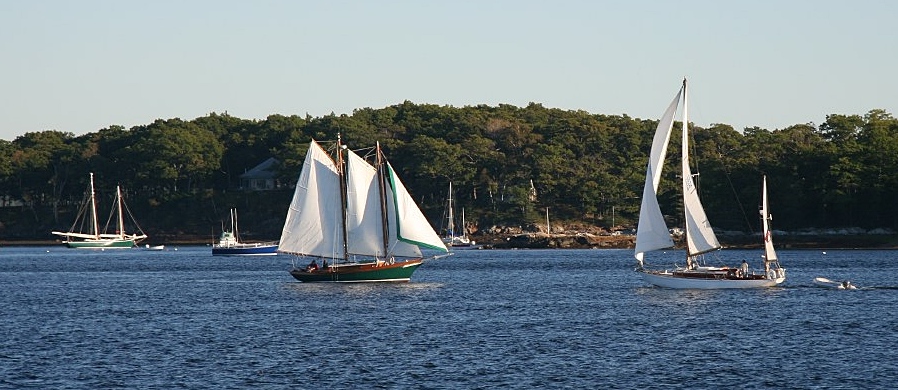
Sailboats crowd Penobscot Bay on any good, windy day in Castine ME.
Castine draws a steady crowd of regular summer visitors who come for the beauty, the seclusion, the quiet, the sailing, the easy summer life. They mostly stay in their own summer houses, owned or rented, so there are few short-term lodgings.
Castine does have a few fine inns, but only a few, and no hotels or motels. This preserves the town's serenity and charm. Click here to see Castine's inns, with prices.
What to See & Do
A Bit of History
Named for the Baron de Saint-Castin, Castine was once the capital of all French Acadia, which included all the lands of what is now French-speaking Canada.
In the winter of 1613 (that is, before the Pilgrims landed at Plymouth MA), Sieur Claude de Turgis de la Tour founded a small trading post here among the Tarrantine Indians.
The struggle for North America's forest, natural, and maritime wealth was already beginning, and the French Fort Pentagoët founded by Turgis de la Tour would be conquered by the English in 1628.
Treaty returned Pentagoët to France in 1635, and during the tumultuous period until 1676, the place changed hands many times. The British took it and called it Penobscot Fort; the French retook it and built the formidable Fort St-Pierre.
At one time the village was the capital of all French Acadia (the lands in what is now Atlantic Canada).
Even the Dutch coveted the fort, and ruled here from 1674 to 1676.
In the latter year Baron de Saint-Castin recaptured the town for France, and opened a trading station. Fortifications were strengthened, and despite raids by the British, the family of Baron de Saint-Castin ruled over the town (now called Bagaduce) even after the wealthy baron himself returned to France, in 1703.
By 1760, however, the fate of French North America was sealed, and Castin's Fort, or Bagaduce, was to be held by the British after that year.
English settlers brought new life to Bagaduce during the 1760s, and dissatisfaction boiled in the English colonies at this period. Some of the townspeople were loyal to the king, others sympathized—actively or passively—with the American revolutionaries.
In 1779 a British naval force came from Nova Scotia, intent on making the town safe for British Loyalists (and thereby influencing the negotiations that would determine the fledgling United States' northern border). The British built Fort George to defend the town.
The challenge to American sovereignty was taken up by the General Court (legislature) of Massachusetts, which governed the territory at the time, and the ill-fated Penobscot Expedition was outfitted and launched at an ultimate cost of $8 million.
Bad luck and bad commanding resulted in the destruction of most of the American force, almost bankrupting the Commonwealth of Massachusetts.
Fort George was enlarged and strengthened over the years, and the town thrived until the border between the US and Canada was determined.
Unhappily for residents of Bagaduce, the boundary was to be the St Stephen River (the present boundary), and not the Penobscot. Those loyal to the British Crown put their houses on boats and sailed them to sites along the coast of what is today New Brunswick at St. Andrews.
Some of the houses thus moved still stand in St Andrews, and residents point to them proudly.
In 1796 the name of Bagaduce was changed to Castine, and although it was occupied by British forces during the War of 1812, it never again saw much military action.
A Walk Through History
Walk around Castine and you're bound to run into evidence of the 350 years of Castine's history, particularly its three forts—Fort Pentagoet, Fort George, and the American Fort Madison—which saw a surprising amount of attack and defense as the town changed hands among the French, British, Americans, and even the Dutch.
Visit the sites of the forts: Fort Pentagoet, near the Wilson Museum on Perkins Road; Fort George, near the entrance to town; and Fort Madison. Fort George is now a State Memorial, kept up by the Bureau of Parks and Recreation.
Wilson Museum
For a closer look, visit the Wilson Museum, 120 Perkins Street, three blocks from Main Street to the southwest.
The museum has exhibits explaining the rich local history, and prehistoric artifacts from the Americas, concentrating on the growth of the human ability to fashion tools.
On Sunday and Wednesday afternoons in July and August, you can also visit the museum's authentic, working blacksmith shop, see Castine's century-old hearses, and take a guided tour (for a nominal fee) of the John Perkins House (1763-1783).
Maine Maritime Academy
Look out to Penobscot Bay and you may see a tall sailing ship or traditional rowing-boat crewed by students from the Maine Maritime Academy, based here in Castine.
Where to Stay
Blue Hill
A town of majestic elm trees, with prim white clapboard homes and churches, Blue Hill, Maine (map) attracts visitors because its most outstanding "attractions" are peace, quiet, summer chamber music, and an easy pace.

Houses along Main Street in Blue Hill ME.
The town was settled in 1762 by colonists from Andover MA, and by 1792 Blue Hill's citizens were turning Maine's forests into ships, and were sending these ships around the world.
In 1816 granite quarries were opened, and stonecutting complemented shipping. From 1879 to 1881, there was also a copper mine here.
What to See & Do
Today, if you're not coming to Blue Hill on vacation, you're probably coming to enroll your child in the George Stevens Academy (1803), a preparatory school.
Or perhaps you've arrived to attend one of the Blue Hill Concert Association's chamber music concert in Kneisel Hall, performed by students and faculty of the summer music school twice weekly in July and August .
You may want to visit the Holt House (1815), home of the Blue Hill Historical Society, open in July and August. The stocky but dignified four-chimney home remains much as it did during Federal days.
Take a look also at the pretty stained-glass windows in the First Congregational Church.
Where to Stay
Blue Hill has a small collection of good inns and restaurants to accommodate summer visitors. You may wish to look at possibilities in neighboring communities as well. Here's a Hotel Map with Prices to help you find one.
Deer Isle & Stonington
No tourist crowds here! The bus tours and RVs may head for Bar Harbor, but Deer Isle and Stonington retain their serene beauty and authenticity.
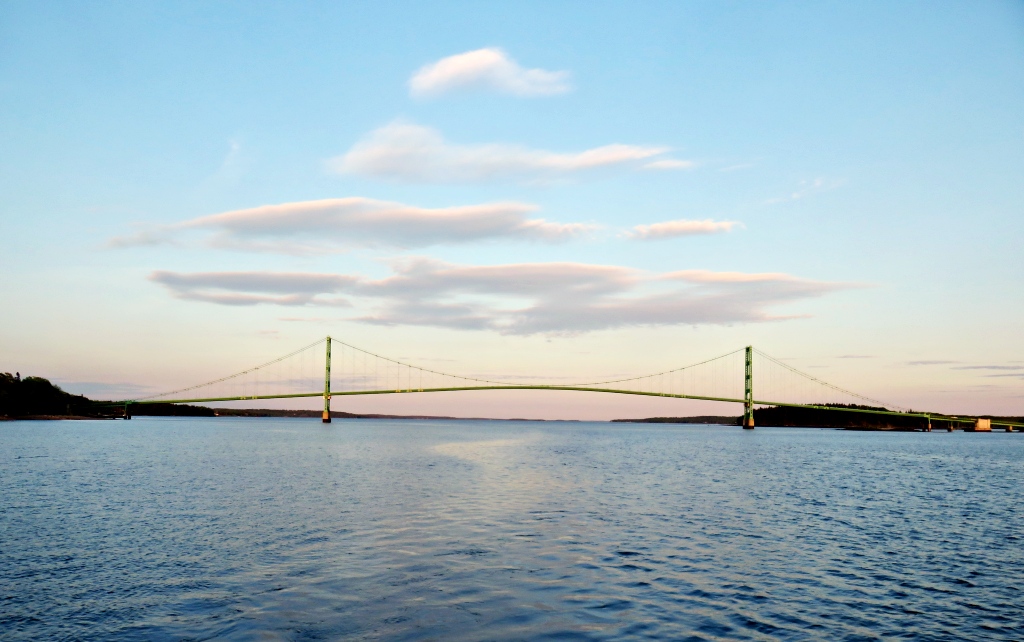
The graceful humpback bridge to Deer Isle, Maine.
Deer Isle has a reputation for being "real Maine," a large island (actually two islands) in Penobscot Bay with several small villages, year-round and seasonal residences, and a traditional Maine ambiance. Stonington, the island's southernmost town, is iconic for being scenic and unspoiled.
Little Deer Isle
Head south from Bucksport or Blue Hill toward Brooksville, eventually following ME Route 15 to the Deer Isle Bridge spanning Eggemoggin Reach, taking you to Little Deer Isle.
(Big) Deer Isle
Turning east, ME 15 leads across a causeway to Scott's Landing on (big) Deer Isle. Another ten miles (16 km) south along ME 15 is Stonington, still truly a fishing village, summer resort, and former granite-quarrying town.
Beyond Stonington is Isle au Haut, part of Acadia National Park. A mail boat (tel 207-367-2468) will take you from Stonington over to Isle au Haut in less than an hour, and you can hike along the park trails—with no crowds in sight.
Stonington
The real Maine coast: a fishing and granite-quarrying town proud that it's no tourist trap. Come here also for the boat to Isle au Haut, part of Acadia National Park.
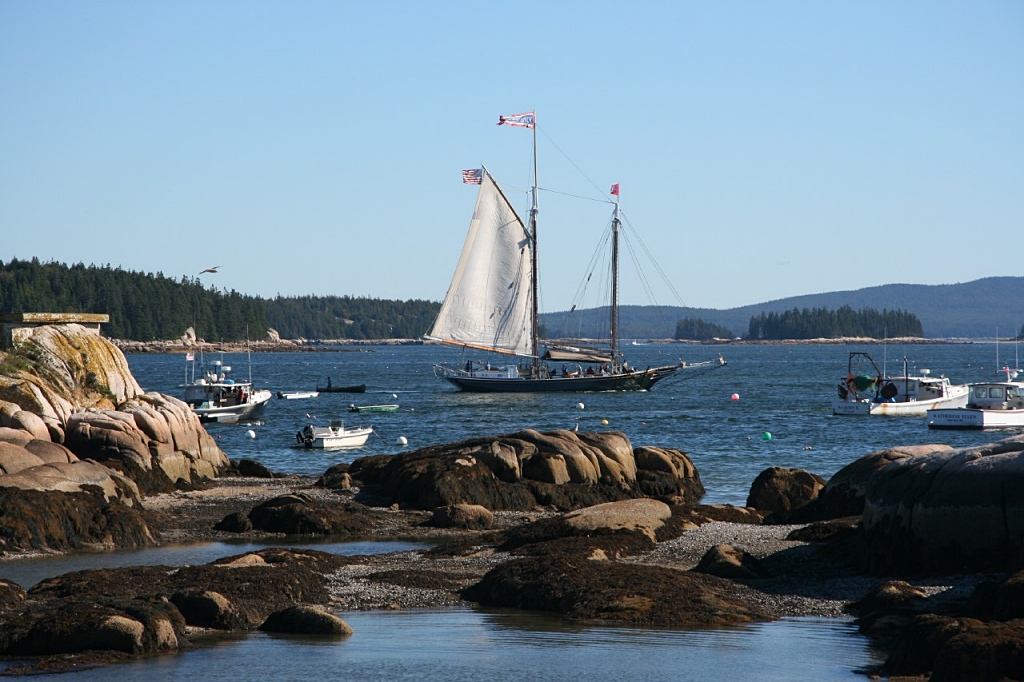
A Maine windjammer sails out of Stonington harbor.
Stonington: the town's name comes from its pink granite, still quarried and worked in small quantities. A monument in the town center—a bronze stone-cutter atop a block of Deer Isle granite—commemorates the craft.
There's parking along the main street and in a lot (follow the signs). Note that the Town Dock is reserved for vehicles working in the fishing and lobster businesses—don't even think of parking there!
What to See & Do
Many visitors drive down to Stonington just for the day. The center of town is along Main Street at the harbor, from the Stonington Public Library to the Opera House art center (map). Main Street has a few small inns, restaurants and shops notable for their lack of hype.
Tourists are easily outnumbered by locals, which makes Stonington an authentic place.
First thing to do is wander along the harbor, enjoy the views, and have an ice cream cone or a lobster roll at the Stonington Ice Cream Company near the library.
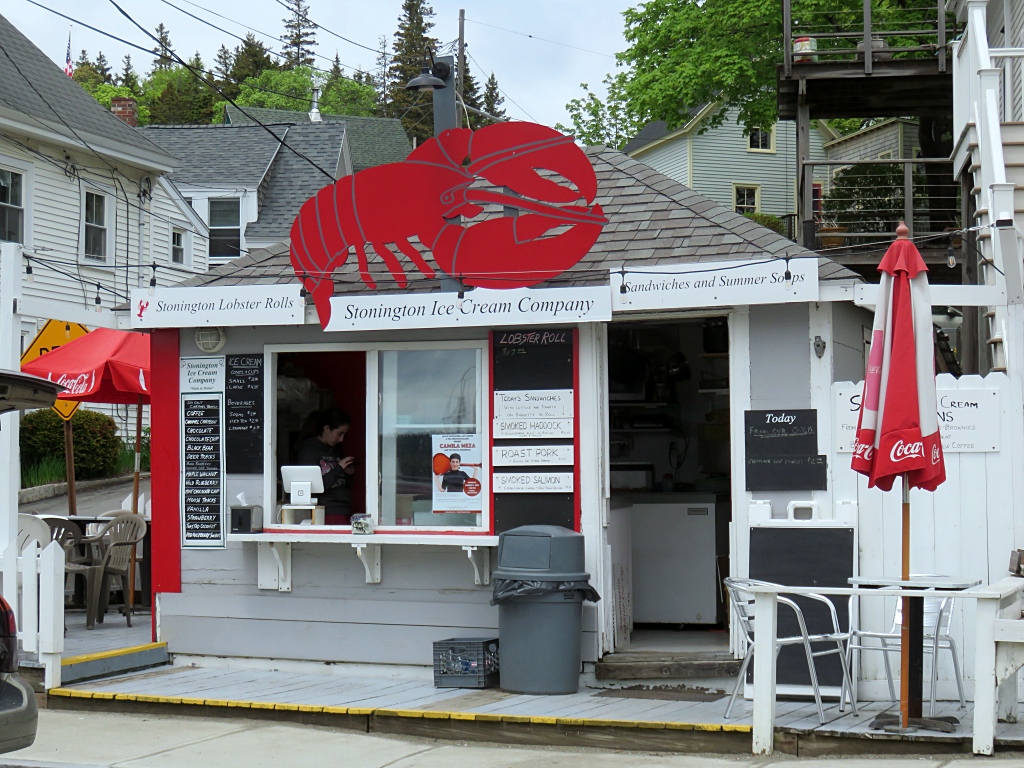
Stonington Ice Cream Company on Main Street.
As you might have guessed, they also serve lobsters!
South of the library is the Maine Center for Coastal Fisheries' Discovery Wharf, a research facility and historical museum with exhibits about the local marine trades. More...
Photography in Stonington
Stonington is popular with photographers because if its unspoiled views and scenes full of character:
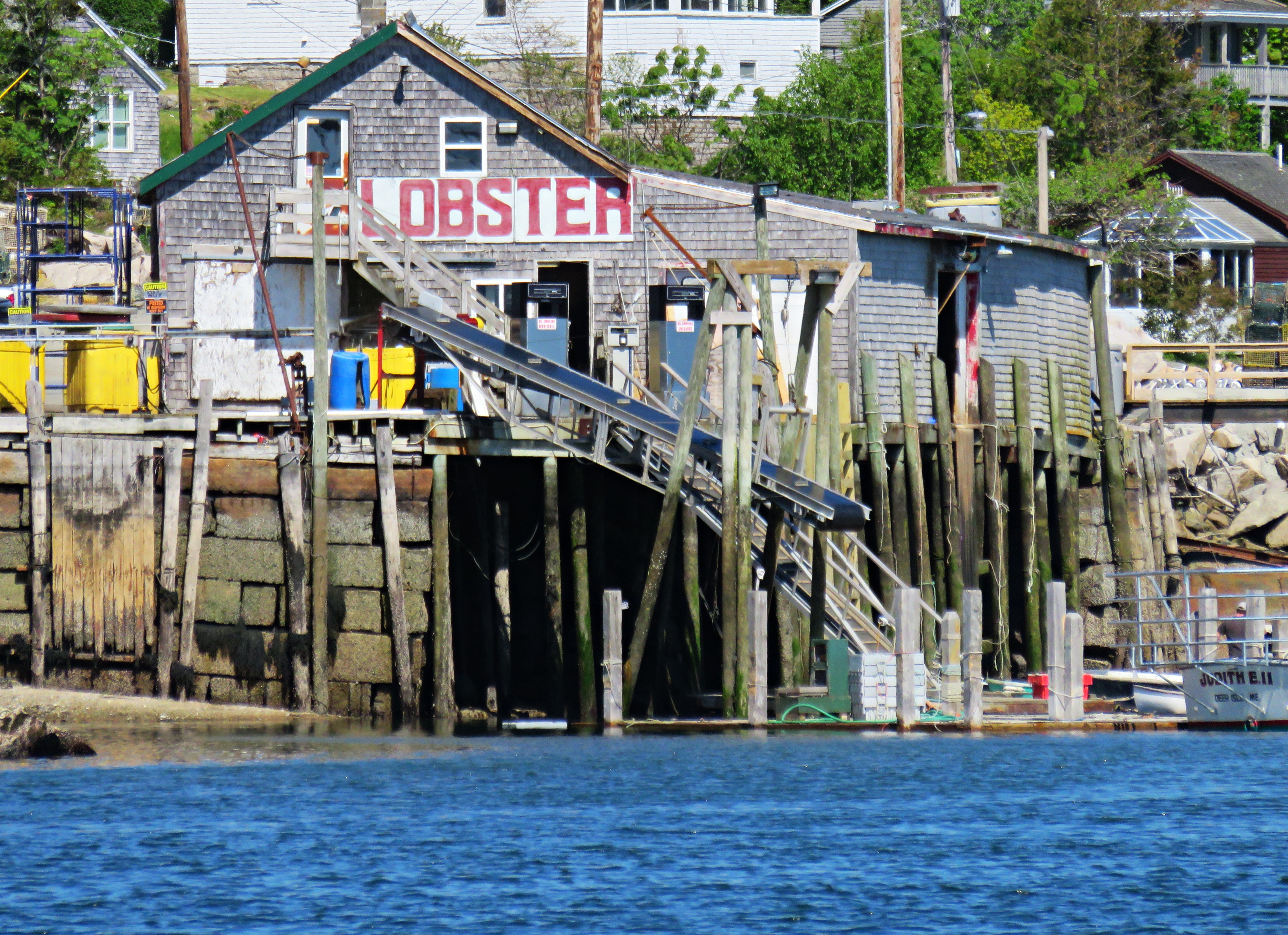
Lobster shack by Stonington harbor.
Where to Stay
Isle au Haut
The Isle au Haut Boat Services (also called "the Mail Boat") departs from Stonington for Isle au Haut pronounced "ILE-uh-HO"). Service to the Town of Isle au Haut Landing operates year-round. In the warm months, the boat also stops at the Acadia National Park Landing at Duck Harbor.
Besides the "mail boat" passenger and freight services, you can take a Penobscot Bay lighthouse tour, a tour to Seal Island to see puffins, and even lobster fishing tours. More...
So what's to do on Isle au Haut? Wander through the village or, if you debark at Duck Harbor, go hiking in this remote territory of Acadia National Park.
